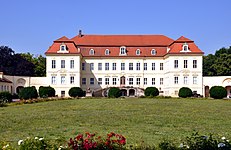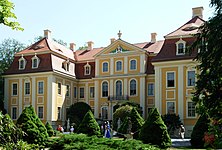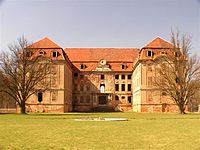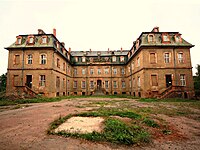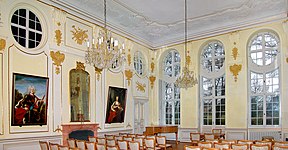Johann Christoph Knoeffel
Johann Christoph Knöffel (* 1686 in Oelsa , Electorate of Saxony ; † March 10, 1752 in Dresden ) was a German architect and builder . He is considered the founder of the Saxon Rococo .
Life
Knoeffel was the son of the master mason Johann Benedikt Knoeffel and his wife Anna Maria , who were involved in the construction of the Dreikönigskirche in Dresden . After only a short school visit, Knöffel started an apprenticeship with a colleague of his father's, Johann Christian Fehre . At the age of 20, Knöffel was acquitted in 1706 as a journeyman in the masons' guild .
Around 1708 Knoeffel got a job as a conductor in the Dresden construction department; but without payment. It was not until two years later that his qualification was granted on account of wages. He supplemented his practical building knowledge and experience with an intensive, self-taught study of architecture.
Knöffel's first independent work as an architect was in the years 1719/20 the conception of the entire complex of Großsedlitz Palace including the garden for the imperial count August Christoph von Wackerbarth , the general building manager of August the strong and superior of the Dresden building authority. In 1722 Knoeffel was promoted to master builder and six years later he became the third master builder; next to Zacharias Longuelune and Matthäus Daniel Pöppelmann .
Knöffel continued the style developed by Pöppelmann, but combined it with French elements of the classicist baroque , such as those introduced by Longuelune in Dresden from 1713. The restrained elegance and aesthetic refinement of the Knoeffelian pilaster strip architecture corresponds at the same time with the rationalism of the Enlightenment and with the contemporary rococo architecture of France, as well as the elegant, clearly arranged interior design. His main work in this regard, and also the first Rococo building in Dresden, is the Kurländer Palais, built for Count Wackerbarth in 1728–29 .
Over the years, Knöffel became more and more of Pöppelmann's assistant and when he gave up the management of the building authority in 1734 due to reasons of age, he was also his successor. During this time, along with a few other clients, he mainly worked for the Saxon Prime Minister Heinrich Graf von Brühl . On behalf of Brühl, he built the Brühl's glories on the Brühl's terrace .
In 1738 Knöffel married Christine Eleonore Stenger in Dresden, a granddaughter of his predecessor Pöppelmann. With her he had a daughter and a son.
When Jean de Bodt died in 1745 , Wackerbarth's successor as general manager of the civil and military buildings, the entire authority was restructured and modernized. Then Knöffel was entrusted with the management of this newly created court and civil building department, which he held until the end of his life. In 1750, Knöffel was appointed Excise Building Director; he had been in charge of this office since 1745 as a representative of Carl Friedrich Pöppelmann . With his designs and offices, Knöffel made a decisive contribution to the so-called Augustan age . Saul's house on Seegasse is considered to be his last work in Dresden .
Knöffel died in Dresden in 1752 and was buried in the Johanniskirchhof . His grave has not been preserved. Knöffel's successor was his pupil Julius Heinrich Schwarze in 1752 , who completed the construction of the Catholic Court Church in Dresden and is considered to be the finisher of the Saxon Rococo; In 1762, Schwarze converted the former Knöffels apartment building into the Coselpalais . In 1776, Schwarze was followed by Friedrich August Krubsacius as Oberlandbaumeister, another Knöffel student; Since 1764 he was professor of architecture at the Dresden Art Academy and so Knöffel's architectural legacy continued to have an impact on Krubsacius' numerous students. Knöffel was the defining architect of the second phase of the Dresden Baroque , which lasted until the last decades of the 18th century.
Works (selection)
- 1720–1721: Upper orangery in the Grosssedlitz baroque garden for Count Wackerbarth
- 1723–1728: Wackerbarth Palace in Dresden Neustadt
- 1721–1731: Baroque Rammenau Castle near Bischofswerda (attributed to Knöffel)
- 1727–1730: Wackerbarth Castle in the Lößnitz
- from 1728: New Zabeltitz Castle for Count Wackerbarth
- 1728/29: Gouvernementshaus in Dresden, later Kurländer Palais , for Count Wackerbarth
- 1736: Villa Cara
- 1738/39 Erdmannsdorf's house
- 1739: Brühl's garden pavilion for Heinrich von Brühl
- 1739–1742: later named Palais Hoym for Johann Adolf von Brühl
- 1740: Design for the old town hall in Dresden, construction carried out by Johann Gottfried Fehre
- 1741–1749: Pförten Castle
- 1743: Gallery building on Brühl's Terrace , Dresden
- 1744–1746 reconstruction of the Johanneum (Dresden)
- 1746–1747: Reconstruction of the Palais Flemming-Sulkowski , Dresden
- 1746: Caesar and Knoeffel house
- 1748: Design for a new hood on the Hausmanns or Königsturm in Merseburg
- 1750: The garden of Schloss Gaussig
- 1750: Reconstruction and expansion of Pöppelmann 's Nischwitz Castle
- 1751: (possibly) Neusorge Castle in Mittweida -Zschöppichen (attributed to Knöffel)
- 1752–1753: Saul's house
- Reconstruction of the city of Forst after the great city fire of 1748 (on behalf of Count Brühl)
- Grochwitz manor near Herzberg
- Hubertusburg
- (possibly) Soli-Deo-Gloria-Haus (attributed to Knöffel)
- (possibly) Schloss Wachau (attributed to Knöffel)
Palais Wackerbarth , Dresden
New Zabeltitz Castle
Ballroom in Oberlichtenau Castle
literature
- Walter Hentschel , Walter May: Johann Christoph Knoeffel. The architect of the Saxon Rococo (= treatises of the Saxon Academy of Sciences in Leipzig. Philological-Historical Class 64, 1, ISSN 0080-5297 ). Akademie-Verlag, Berlin 1973.
- Walter May: Knoeffel, Johann Christoph. In: New German Biography (NDB). Volume 12, Duncker & Humblot, Berlin 1980, ISBN 3-428-00193-1 , p. 200 f. ( Digitized version ).
Footnotes
- ↑ life data after the entry in the Saxon biography
- ^ Hagen Bächler and Monika Schlechte: Guide to the Baroque in Dresden , Dortmund 1991, p. 23
- ^ Stefan Hertzig: Johann Christoph Knoeffel. In: ders .: The late Baroque town house in Dresden 1738–1790 . Society of Historical Neumarkt Dresden e. V., Dresden 2007, ISBN 3-9807739-4-9 , pp. 221-225 .
Web links
| predecessor | Office | successor |
|---|---|---|
| without | Electoral Saxon Oberland Master Builder 1728–1752 |
Julius Heinrich Black |
| Carl Friedrich Poeppelmann | Electoral Saxon General Excise Building Director 1750–1752 |
Samuel Gotthelf Locke |
| personal data | |
|---|---|
| SURNAME | Knoeffel, Johann Christoph |
| BRIEF DESCRIPTION | German builder and architect |
| DATE OF BIRTH | 1686 |
| PLACE OF BIRTH | Oelsa , Electorate of Saxony |
| DATE OF DEATH | March 10, 1752 |
| Place of death | Dresden |



